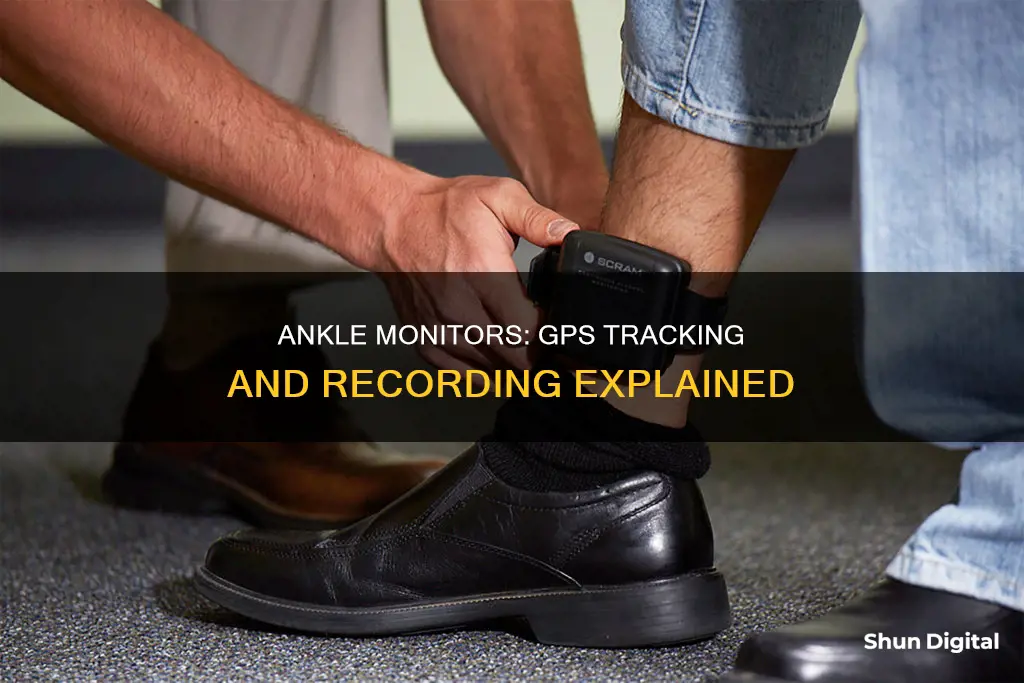
GPS ankle monitors are often used as an alternative to incarceration, allowing non-violent offenders to serve their sentences outside of traditional correctional facilities. These devices are typically used to track an individual's movement and location, and in some cases, can even monitor alcohol consumption. While GPS ankle monitors offer a range of benefits, including reduced jail overcrowding and rehabilitation opportunities, they have also raised privacy concerns. In this article, we will explore the intricacies of GPS ankle monitors, their effectiveness, and the ethical implications surrounding their use.
| Characteristics | Values |
|---|---|
| Purpose | To monitor individuals who are subject to legal restrictions |
| Technology | Global Positioning System (GPS) |
| Components | GPS module, cellular module, electronic strap, software system |
| Communication System | Cellular networks |
| Alerts | Triggered when predefined boundaries are violated |
| Charging | Generally, individuals wearing the device are responsible for charging it |
| Accuracy | May be affected by environmental conditions and signal interference |
| Privacy | Legitimate concerns; requires a well-regulated legal framework |
| Benefits | Reduced jail overcrowding, rehabilitation, cost savings |
What You'll Learn

GPS ankle monitors can record conversations without consent
GPS ankle monitors are increasingly being used as an alternative to incarceration, particularly for non-violent offenders. They are often used for people awaiting trial, those on probation or parole, and those facing immigration proceedings. The monitors allow authorities to keep track of individuals, ensuring they stay within certain boundaries and comply with court-imposed restrictions. While the primary purpose of GPS ankle monitors is to provide constant oversight of an individual's movements and location, concerns have been raised about their ability to record conversations without the wearer's consent.
In 2014, a technician testified in a case in Puerto Rico that the ReliAlert XC3 device, manufactured by the Track Group, could be turned on without warning, enabling the listening and speaking capabilities without the wearer's knowledge. This particular device is designed to play a three-note sound when an official calls and a recording begins. However, the technician's testimony raised concerns about the potential invasion of privacy and the possibility of recording incriminating information without the wearer's consent.
The Track Group, the only company known to have devices with built-in communication capabilities at the time, denied any substantiated claims of abuse involving the monitor. They asserted that there were disclosures and conditions provided to individuals wearing the device, including consent to use a recorded line for communications. Despite this, the potential for abuse and the invasion of privacy have sparked debates about the ethical and legal implications of such devices.
The use of GPS ankle monitors that can record conversations without consent raises several concerns. Firstly, it infringes on the right to privacy, as conversations that individuals believe to be private could be recorded and potentially used against them. Additionally, the constant monitoring and recording of conversations could lead to self-censorship, inhibiting individuals from freely expressing their thoughts and opinions. Furthermore, the potential for abuse or misuse of the recorded information is a significant concern, especially if it falls into the wrong hands.
While the use of GPS ankle monitors can provide benefits in terms of reducing jail overcrowding and promoting rehabilitation, addressing the privacy concerns associated with conversation recording is crucial. It underscores the importance of implementing strict regulations and safeguards to protect the rights of individuals subjected to this form of monitoring.
Choosing the Right Monitor: Understanding Size and Specifications
You may want to see also

They can be used as an alternative to incarceration
GPS ankle monitors are increasingly viewed as a more humane alternative to incarceration. They are often used for individuals on probation or parole or those awaiting trial. They can also be used for low-risk individuals convicted of a crime who are not considered a danger to the community.
One of the main benefits of GPS ankle monitors is that they allow individuals to remain in the community, maintain their jobs, and support their families. This can make it easier for them to reintegrate into society once their sentences are completed. GPS ankle monitors are also less expensive than incarceration, saving taxpayers and courts money. Additionally, studies have shown that individuals under house arrest have lower recidivism rates than those in jail, as it promotes rehabilitation.
However, it is important to note that GPS ankle monitors are not without their disadvantages. They can be uncomfortable and cause skin irritation. Individuals with ankle monitors are subject to strict rules and regulations, and any violation can result in additional penalties or incarceration. The rules are often vague and open to interpretation, and the nature and number of restrictions may lead to reincarceration for technical violations. For example, failure to keep the device charged could result in jail time.
Furthermore, while GPS ankle monitors are meant to be less restrictive than prison, a report by Kate Weisburd, an associate professor of law at George Washington University, found that they deprive people of fundamental rights, violate privacy norms, and undermine family and social relationships. The report also highlights the wealth extraction associated with GPS ankle monitors, as most jurisdictions require individuals to pay expensive user fees, which can range from $2,800 to $5,000 per year.
In conclusion, while GPS ankle monitors can be a viable alternative to incarceration in certain cases, it is important to carefully consider the advantages and disadvantages and the potential impact on the individual's rights, privacy, and financial situation.
Acer Monitor Sizes: Understanding the Dimensions for Your Display
You may want to see also

They can reduce jail overcrowding and costs
GPS ankle monitors are increasingly being used to reduce the number of incarcerated people and to allow for the release of people without money for bail. They are also used as an alternative to pre-trial detention or as a condition of probation.
GPS ankle monitors are a cheaper alternative to incarceration, easing overcrowding in jails and prisons. They allow offenders to continue working and supporting their families. GPS ankle monitors can also alert law enforcement if there is an infraction, for example, if a sex offender approaches a school or playground, or a domestic abuser veers near a victim.
In San Francisco, the number of people released from jail onto electronic monitors tripled after a 2018 ruling forced courts to release more defendants without bail. In Marion County, Indiana, where jail overcrowding is routine, roughly 5,000 defendants were put on monitors last year.
A 2013 study in California, sponsored by the Justice Department's National Institute of Justice, found that high-risk sex offenders released on parole and fitted with GPS devices had a recidivism rate 38% lower than those who did not have the device.
However, GPS ankle monitors can be ruinous to poor defendants. States and counties often outsource the task of monitoring the devices to for-profit corporations, which in turn cover the costs by charging offenders to pay for the devices themselves – sometimes as much as $10 a day. In some cases, people are pleading guilty because it's cheaper to be on probation than it is to be on electronic monitoring.
Ford F-150: Blind Spot Monitoring System Explained
You may want to see also

They can be used to ensure offenders stay away from victims
GPS ankle monitors are increasingly being used to enforce restraining orders and keep survivors of domestic violence safe. In cases of domestic violence, ankle monitors can be used to ensure that the offender maintains a required distance from the victim.
The monitors use GPS technology to track the wearer's movements and position, allowing authorities to be alerted if the offender enters a restricted zone. This enables survivors of domestic violence to feel safer, knowing that their abuser cannot come near them without being detected. The technology also provides critical evidence to support an arrest and conviction for violating a restraining order, which can be difficult to obtain otherwise.
For example, a survivor may see their abuser drive by but may not be sure, so they don't call the police. With GPS tracking, it's not just the survivor's word against the abuser's—the technology can show the abuser's movements and prove a violation. This also helps to address the issue of abusers claiming ignorance and can lead to fewer arrests and higher parole compliance.
In addition to protecting survivors, GPS ankle monitors can also provide an alternative to incarceration. By wearing a monitor, individuals can continue their daily routines, improve their social and vocational skills, and maintain employment while being supervised. This approach promotes rehabilitation and increases the chances of successful reintegration into society, contributing to the criminal justice system's goals of public safety and rehabilitation.
However, it's important to note that GPS ankle monitors are not a perfect solution. There may be device malfunctions, and the cost of monitoring can be high. Additionally, survivors may be given a false sense of security, as the technology cannot guarantee 100% accuracy due to potential signal interference and environmental conditions that hinder satellite signal reception.
Finding Your Monitor's Size on a MacBook
You may want to see also

They can be used to monitor alcohol consumption
GPS ankle monitors are often used to monitor the location and movement of individuals who are either serving their sentences or awaiting trial. While the primary function of these devices is location tracking, they can also be used to monitor alcohol consumption in certain cases. Here's how:
Transdermal Alcohol Testing
GPS ankle monitors, such as the SCRAM CAM® Continuous Alcohol Monitoring bracelet, can be used to monitor alcohol consumption through transdermal alcohol testing. This involves automatically sampling the wearer's perspiration at regular intervals, typically every 30 minutes. When a person consumes alcohol, a small amount is excreted through the skin in the form of insensible perspiration. The ankle monitor detects this by using an electrochemical fuel cell to analyse the wearer's sweat. This method eliminates testing gaps and helps hold individuals accountable for their alcohol consumption.
Detecting Alcohol Molecules
The ankle monitor's technology can identify even trace amounts of alcohol in the wearer's system. It can detect ethanol molecules present in perspiration, providing reliable and accurate results. This high level of sensitivity means that even a tiny sip of alcohol or a mouthwash gargle can potentially be detected. As a result, individuals wearing these monitors are strongly advised to abstain from consuming any alcohol to avoid legal repercussions.
Alerting Authorities
When the ankle monitor detects the presence of alcohol, it triggers an alert. The data is then uploaded via modem and monitored by a private company, which reports any positive alcohol tests to the relevant authorities, such as the court or the probation department. This information can be used to enforce court orders and increase community safety, especially in cases involving drunk driving, domestic violence, or substance abuse.
Encouraging Behaviour Change
Continuous alcohol monitoring through ankle monitors has been proven to support long-term behaviour change. It complements treatment for alcohol dependence or addiction by encouraging sobriety and higher compliance rates with court orders. Studies have shown that wearing an alcohol-monitoring ankle monitor for at least 90 days, coupled with alcohol treatment, can reduce the risk of reoffending for individuals convicted of driving under the influence.
Limitations and Myths
It is important to note that not all GPS ankle monitors are equipped with alcohol-detecting capabilities. While some advanced monitors may incorporate both GPS tracking and alcohol detection, the primary focus of GPS monitors is typically location tracking. Additionally, contrary to popular belief, ankle monitors cannot detect alcohol through skin contact or myths like hand sanitiser triggering the device. They are specifically designed to detect alcohol consumed orally, not surface-level applications.
Monitoring Globe Broadband Usage: A Step-by-Step Guide
You may want to see also
Frequently asked questions
GPS ankle monitors are used to track an individual's location and movements. They are often used as an alternative to incarceration, allowing individuals to maintain a level of freedom while still being monitored by authorities.
GPS ankle monitors use Global Positioning System (GPS) technology to determine an individual's location. They receive signals from multiple GPS satellites and estimate the distance from the wearer to each satellite. This information is then transmitted to monitoring stations, allowing authorities to track the individual's movements in real time.
GPS ankle monitors offer several benefits. They reduce jail overcrowding and costs by providing an alternative to incarceration for non-violent offenders. They also promote rehabilitation and reintegration by allowing individuals to maintain employment and daily routines while being monitored. Additionally, GPS ankle monitors can enhance public safety by ensuring individuals adhere to imposed restrictions.
While GPS ankle monitors offer reliable tracking, they have certain limitations. Environmental factors such as thick buildings or dense foliage may hinder their ability to receive satellite signals. Additionally, electronic devices or structures emitting strong electromagnetic signals may cause signal interference, affecting tracking accuracy.
The use of GPS ankle monitors raises legitimate privacy concerns. While they aim to balance public safety and the need for rehabilitation, it is crucial to respect the privacy rights of individuals being tracked. Authorities should implement GPS ankle monitors within a legal framework that outlines specific guidelines and safeguards to protect privacy.







